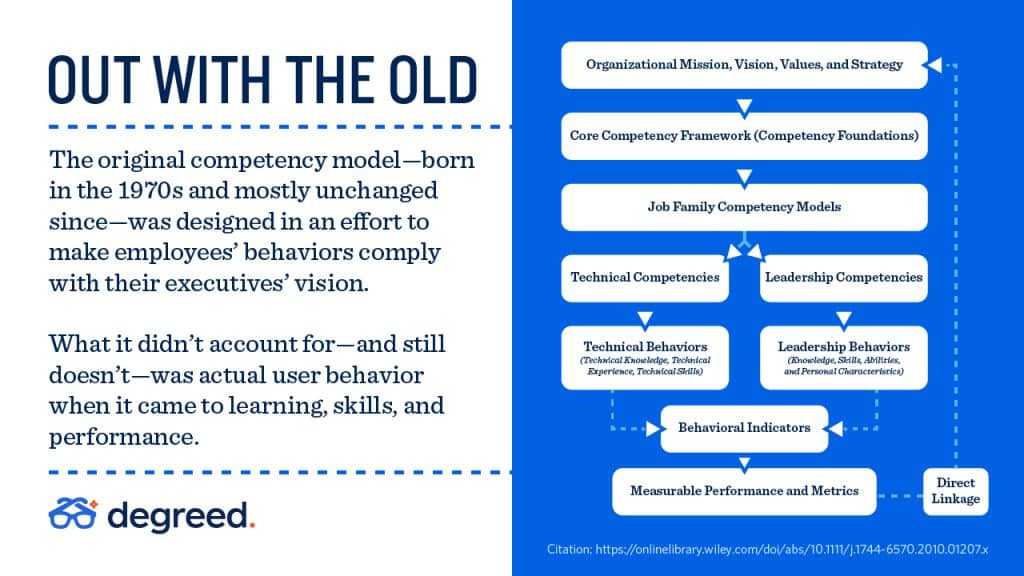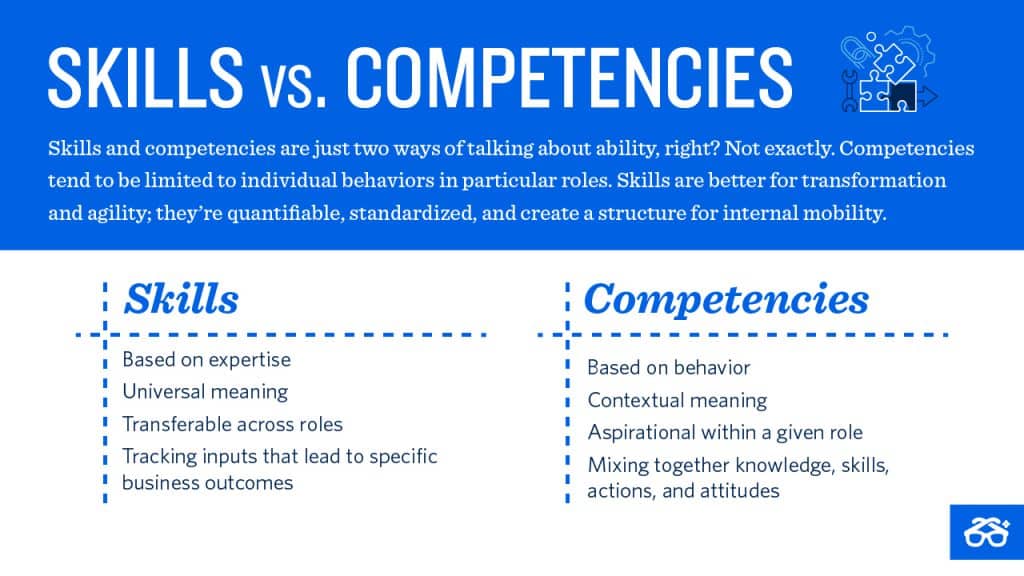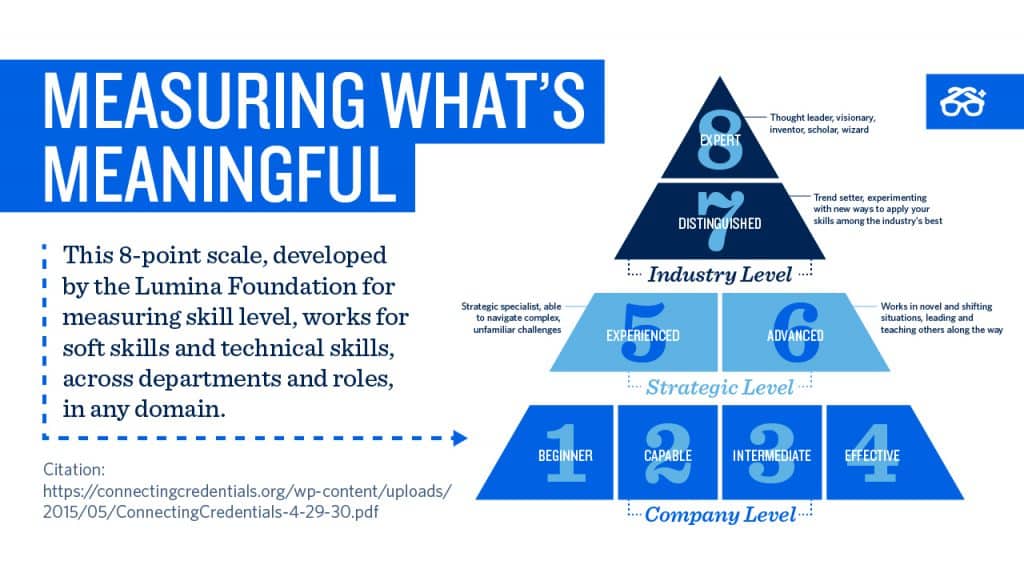Competency models are complicated. The list of competencies is often never-ending, bloated with dozens of buzzwords, and each one typically includes several repetitive paragraphs to describe various levels of performance. In short, they’re hard to quantify and that makes them hard to manage.
This limits your organization’s ability to analyze and adapt. Competency models were not designed for agility or big data. They were born in the 1970s in an effort to help employees’ behavior comply with executives’ visions.

What is a Competency Model?
A competency model entails more than just knowledge and skills; it’s also a mix of behaviors and attitudes, which all factor into performance. But organizations can’t gather actionable data if they try to measure everything at once, and employees are unlikely to check these lengthy rubrics when they need to learn something new.
That’s why newer strategies keep the focus on skills, the language that people actually use when talking about their own growth. When organizations track skills, they gather targeted data that can offer reliable insights and inform business and HR decisions.
So if you’re still using a competency model, what would it take to make that first step towards a skills model? First, understand the difference between the two. Then, start breaking competencies down to their basic building blocks: skills. Follow these five steps to get started.
1. The Fundamental Principles
Making any major change requires a clear sense of direction. At Degreed, we are committed to three fundamental principles that structure our skills strategy. These core beliefs can guide anyone looking to learn the language of skills.
- Business-Driven: If skills are not solving real business problems, they are not serving their purpose. This is not about simply re-writing the list of competencies. It’s about finding solutions that benefit both organizations while also promoting growth on an individual level.
- Adaptable: A skills solution must adapt to different contexts and evolve with markets and trends. Competencies are often specific to a role or department, which limits comparison between roles and therefore internal mobility as well as scalability. But skills can be a universal language, allowing managers to assess employees’ abilities across teams and roles. In short, it allows them to compare apples to apples.
- Market Driven: The market needs to help you decide what skills to begin targeting. What are people following, tagging, or searching for? This can indicate patterns, burgeoning trends, or new abilities that could potentially benefit your organization. Instead of referring to a rubric, these data points tell us what actually matters in the market, and they’re continuously updating.
2. The Basic Differences
Skills and competencies can seem similar– many don’t know the difference. These are just two ways of talking about ability, right?
Not exactly. Competencies tend to focus on individual behaviors in particular roles. For example, the description of “Balancing Stakeholders” for a Project Manager would include details that are not relevant to the same competency for an IT Director or Sales Director.
This makes it difficult to determine how one would perform in another role. Skills, on the other hand, are based on expertise that can be transferred across areas.

Competency models are useful for steady progress within the status quo— they can tell people how to improve incrementally in their current roles. But skills are better for transformation and agility; they’re quantifiable, standardized, and create a structure for internal mobility.
Finally, competencies tend to blend many skills together with knowledge, behavior, and attitudes. If someone’s competency is lacking, it can be hard to explain why. Are they weak on a specific skill? Are bad habits causing the problem? Are they uninterested in their roles? The competency model alone probably can’t give the answers.
3. The Task of Translation
To create a structure around skills, you’ll need to start assessing competencies to then break each one down into skills. Luckily, you don’t need to instantly abandon your competency model to learn the language of skills. The challenge is determining the translation between the two models.
Typically, any given competency includes an array of skills. As an example, consider all the skills that go into the competency of “Business Acumen.”

To show the competency of business acumen, an employee needs skills with making and managing budgets, with market research and marketing strategy, with competitive analysis and business growth.
Instead of communicating in terms of lofty goals, your organization can break down each competency into several skills— almost like the building blocks of competencies. Then these specific skills can be tracked and developed for each individual across any role. If you’re interested in the process of actually breaking down competencies into individual skills, check out one of our latest blogs for more insight.
4. The Skills Scale
Once your competencies have been translated to skills, how do you actually start measuring those skills and the acquisition of new ones? Are there clear answers to tough questions about comparison and transferability?
The Lumina Foundation has put forward an elegant solution for scoring skills. They developed an intuitive eight-point scale that can be applied in any domain.

The lowest four levels cover the typical range of competencies. Level 1 is a novice and Level 2 is a contributor to the team. At Level 3, the worker can operate independently and at Level 4, the employee follows the best practices.
The next two levels move from competency to strategy. Level 5 entails navigating complex situations; Level 6 includes leading others through those challenges.
The highest levels represent industry-leading mastery. At Level 7, someone is setting trends and experimenting with new applications. Finally, Level 8 means becoming a visionary, an inventor, a thought leader.
This eight-point scale works for soft skills and technical skills, across departments and roles. Once competencies are translated into skills, you can actually track your people’s progress over time, even if they change roles or the organization changes its strategy.
5. The Longer Journey
If you shift from competencies to skills, what will happen next? What will people in your organization do differently?
With the right tools, the shift to a skills strategy can catalyze a broader transformation, as people embark on unique journeys to develop new skills.
It starts with a personalized platform that recognizes what people want to learn and which resources will help them grow their skills—like Degreed’s LXP. People can collaborate on the platform, finding those who are interested in similar skills; they can learn together by forming groups, sharing content, following each other, and posting comments.

People can also take control using the language of skills. They can search for learning content tagged with the skills they want to develop, or they can even tag their own personal skills, adding them to their profiles and updating their ratings over time. Ultimately, this leads to long-term transformation. Organizations can measure their changing capabilities and adapt their strategies as needed. And perhaps most importantly, this system will continuously update with your peoples’ skills, so it’s never antiquated.
The defining dynamics of our era — big data and digital disruption — demand a new approach to talent development. Don’t get stuck on the preordained priorities and fixed structures of competency models. Want to learn more about how the language of skills can help gather insight and build agility at your organization? Reach out to a Degreed representative today!
